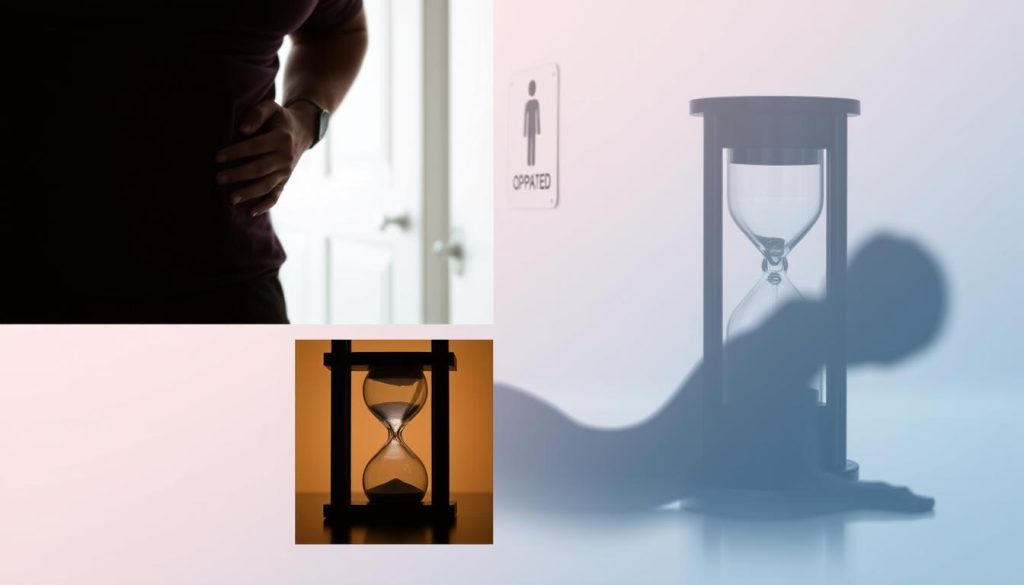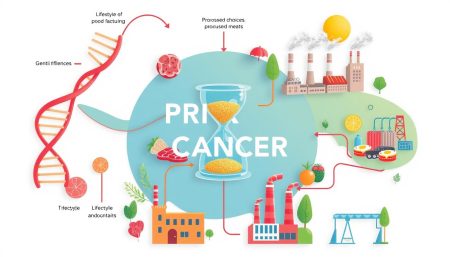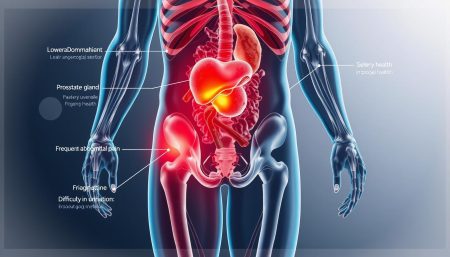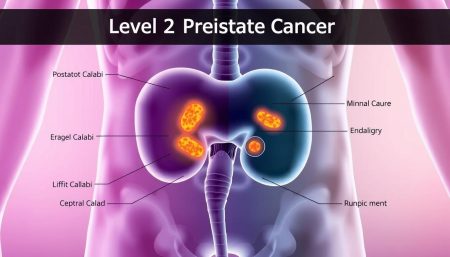Spotting prostate cancer symptoms early is key to effective treatment. Men over 50 should watch for changes in their urinary habits and overall health closely. Prostate cancer signs often start small but can grow fast if ignored.
Prostate cancer symptoms can vary a lot. Many men first notice urinary symptoms. These include trouble starting or stopping urination, a weak urine flow, or needing to urinate more often, even at night.
While these signs don’t always mean cancer, they’re worth checking with a doctor. Regular check-ups and talking openly with healthcare providers help catch prostate cancer early. Knowing the different symptoms helps men take care of their health and get medical help when needed.
Understanding Prostate Cancer Symptoms and Early Detection
Knowing prostate cancer symptoms and getting early detection can save lives. Men should learn the signs and risk factors. This helps them take care of their health early on.
Why Early Detection Matters
Finding prostate cancer early can greatly improve treatment success and survival chances. In its early stages, the disease is easier to treat. Regular health checks and screenings are key to catching problems early.
Risk Factors and Age Considerations
Several things can raise your risk of getting prostate cancer. Age is a big one, with risk going up after 50. Family history and ethnicity also matter. African American men, for example, face a higher risk and might need screenings sooner.
| Risk Factor | Impact Level | Screening Recommendation |
|---|---|---|
| Age over 50 | High | Annual screening |
| Family History | Moderate to High | Start screening at 45 |
| African American | High | Start screening at 45 |
| Obesity | Moderate | Regular screening with lifestyle changes |
The Role of Regular Screening
Regular screenings are essential for catching prostate cancer early. These include PSA blood tests and digital rectal exams. Men should talk to their doctors about their risk factors to set up the right screening schedule. Early detection through these methods can lead to better treatment options and a better life.
Urinary Changes as Primary Warning Signs
Urinary symptoms can be early signs of prostate issues, like cancer. Spotting these changes early can lead to timely medical care and better results. Let’s look at the main urinary changes to watch for.
Frequent Urination Patterns
Going to the bathroom more often, or at night, might signal prostate problems. If you’re visiting the bathroom more than usual, it’s something to note. This could affect your daily life and sleep.
Difficulty Starting or Stopping Urination
Having trouble starting or stopping urine flow is another warning sign. You might struggle to start or notice dribbling after you think you’re done. These issues can be annoying and might show prostate changes.
Changes in Urine Stream Strength
A weak urine stream is a common sign of prostate issues. You might see a decrease in force or a stream that starts and stops. This makes it hard to fully empty your bladder.
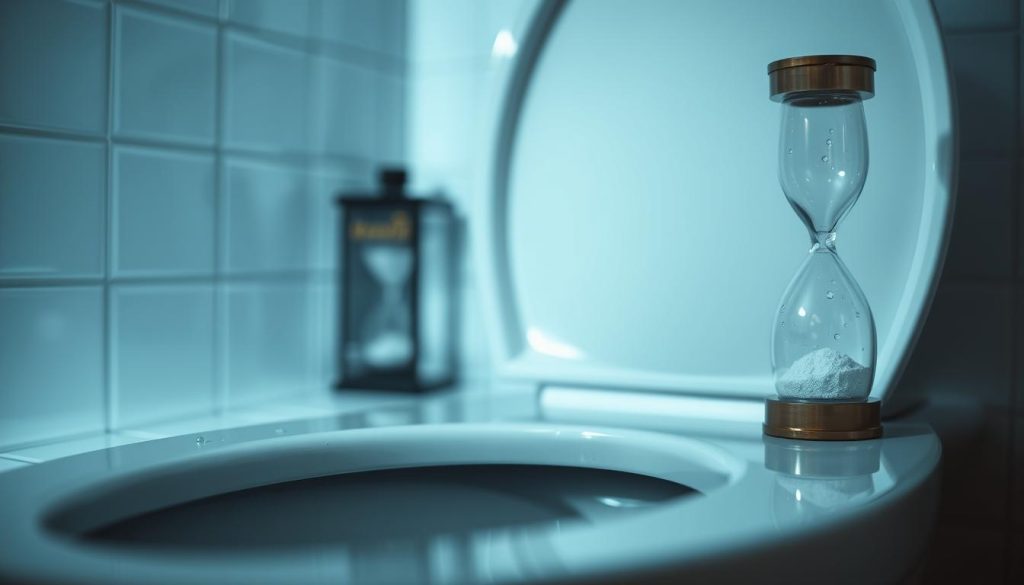
| Urinary Symptom | Description | Potential Concern |
|---|---|---|
| Frequent urination | Urinating more than 8 times daily | Prostate enlargement or cancer |
| Difficulty starting | Delayed or strained urination start | Prostate obstruction |
| Weak urine stream | Reduced force or interrupted flow | Prostate blockage or nerve issues |
If you notice these urinary symptoms, seeing a healthcare professional is key. While they don’t always mean cancer, catching it early can greatly improve treatment outcomes.
Blood in Urine or Semen: When to Be Concerned
Seeing blood in your urine or semen can be scary. This symptom, known as hematuria, is a sign that shouldn’t be ignored. It might not always mean cancer, but it’s important to know when to see a doctor.
Blood in urine can look like a pink, red, or cola color. It might not be easy to see with the naked eye but can be found through urinalysis. If you notice this, don’t worry, but do make an appointment with your doctor right away.
Many things can cause blood in urine or semen:
- Urinary tract infections
- Kidney stones
- Enlarged prostate
- Prostate cancer
If blood in urine is with other symptoms like needing to pee a lot, trouble starting or stopping, or pelvic pain, it could mean prostate problems, including cancer.
| Symptom | Possible Causes | Action Required |
|---|---|---|
| Blood in urine | UTI, kidney stones, prostate issues | Consult doctor within a week |
| Blood in semen | Prostatitis, prostate cancer | Consult doctor within two weeks |
| Blood in urine with pain | Kidney stones, advanced prostate cancer | Seek immediate medical attention |
Early detection is vital in fighting prostate cancer. If you see blood in your urine or semen, and you have other urinary symptoms, don’t wait to get medical help.
Common Prostate Cancer Symptoms You Shouldn’t Ignore
Spotting prostate cancer symptoms early is key to better treatment. Men need to know about signs that show prostate health issues.
Physical Symptoms
Physical changes often hint at prostate cancer. Look out for unexplained weight loss, swelling in the legs or pelvic area, and changes in bladder habits. Painful urination is a big warning sign.
Behavioral Changes
Prostate cancer can also show up in behavior. You might feel more tired, lose your appetite, or feel mood swings. Some men have trouble sleeping because they need to pee a lot at night.
Pain-Related Indicators
Pain is a critical symptom of prostate cancer. It can be pain when you pee or ejaculate, or constant pain in your lower back, hips, or pelvis. Any unusual pain in these spots means you should see a doctor right away.
| Symptom Category | Common Signs | Action Required |
|---|---|---|
| Physical | Weight loss, swelling, urinary changes | Consult doctor if persistent |
| Behavioral | Fatigue, appetite loss, mood shifts | Monitor and report changes |
| Pain-Related | Painful urination, lower back pain | Seek immediate medical advice |
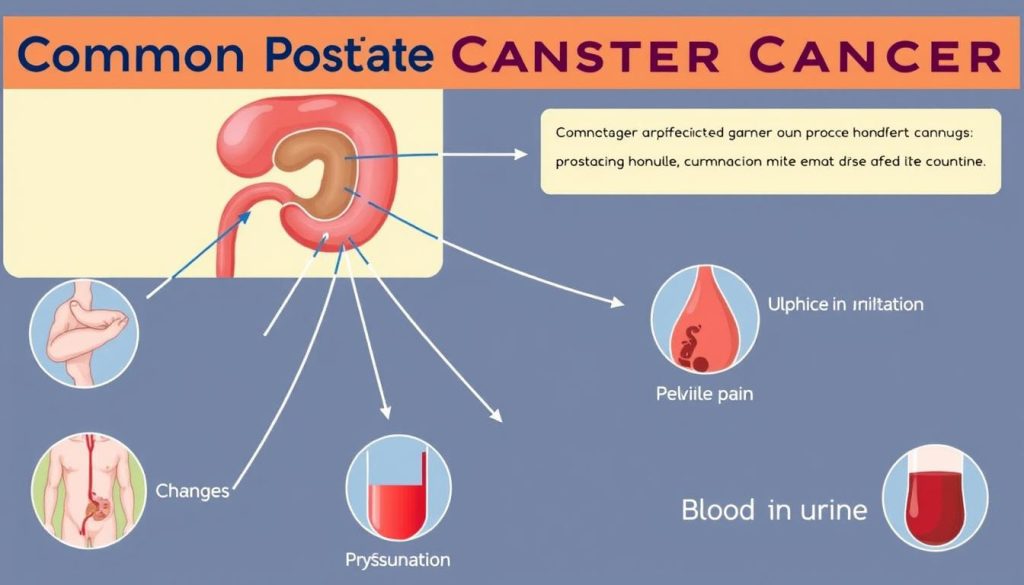
Being alert to these symptoms can help catch prostate cancer early. If you notice any, like painful urination or ongoing discomfort, get medical help right away.
Pelvic Pain and Discomfort: Key Indicators
Pelvic pain is a symptom that should not be ignored. It’s not always a sign of prostate cancer, but it’s important to know when it might be. Men with persistent or worsening pelvic pain should pay close attention to its nature and location.
Prostate cancer often causes a dull ache or pressure in the pelvic area. This pain may spread to the lower back or rectum. Unlike sharp pains from kidney stones or burning from urinary tract infections, prostate pain is usually constant and develops slowly.
Some key signs of pelvic pain related to the prostate include:
- Pain that worsens when sitting
- Discomfort during or after ejaculation
- A feeling of heaviness in the pelvic region
- Pain that extends to the groin or inner thighs
Pelvic pain can have many causes, not just prostate cancer. Benign prostatic hyperplasia (BPH) or prostatitis can also cause similar symptoms. If you have persistent pelvic discomfort, see a healthcare provider for a proper check-up and diagnosis.
Early detection is key to managing prostate health. Regular check-ups and talking openly with your doctor about any unusual symptoms can greatly improve your health.
Sexual Function Changes and Prostate Health
Prostate health is key for men’s sexual function. When prostate cancer strikes, it can change sexual performance and overall health a lot.
Erectile Dysfunction Concerns
Erectile dysfunction is a common symptom of prostate cancer. Many men find it hard to get or keep erections during and after treatment. This can happen because of nerve damage or less blood flow to the penis.

Impact on Sexual Performance
Prostate cancer and its treatments can mess with sexual function in many ways. Some men see a drop in libido, changes in orgasm intensity, or pain during ejaculation. These issues can really hurt intimate relationships and quality of life.
Related Hormonal Changes
Hormonal therapies for prostate cancer can cause more sexual side effects. Lower testosterone levels can lead to less sex drive, hot flashes, and mood swings. Some men also get breast enlargement or tenderness.
Talking about sexual function changes with your doctor is important. They can help find ways to manage symptoms and improve sexual health. Remember, talking openly with your partner is key to facing these challenges together.
Lower Back Pain: A Silent Warning Sign
Lower back pain is a common problem that affects millions. It’s often seen as a result of bad posture or strain. But, it can also be a silent warning sign of a serious issue. Sometimes, it might be a sign of prostate cancer symptoms that need attention.
Prostate cancer can spread to bones like the spine and pelvis. This can cause ongoing pain in the lower back. Unlike usual back pain, cancer-related pain doesn’t go away and can get worse.
Here are some key differences between usual back pain and cancer-related pain:
- Duration: Pain lasting more than a few weeks
- Intensity: Gradually increasing discomfort
- Nature: Deep, constant ache
- Location: Pain focused in the lower back and hips
If you have persistent lower back pain, it’s important to see a doctor. This is true if you also have other urinary or sexual issues. Early treatment of prostate cancer can greatly improve your chances of recovery. Remember, while back pain alone doesn’t mean cancer, it’s always wise to check your health.
Night-Time Urination Frequency and Cancer Risk
Night-time urination, or nocturia, can signal health problems, including prostate cancer. Knowing the difference between normal and abnormal patterns is key for early detection.

Normal vs. Abnormal Patterns
Most adults sleep six to eight hours without needing to urinate. Waking up once is normal. But, waking up multiple times each night is a warning sign.
Frequent urination, often at night, is a common sign of prostate cancer. It’s vital to watch for changes in your urination habits. If issues persist, see a doctor.
Impact on Sleep Quality
Nocturia can harm your sleep quality and health. Waking up to urinate disrupts your sleep cycle. This leads to daytime fatigue, decreased concentration, and mood swings.
| Number of Nightly Urinations | Sleep Quality Impact | Potential Health Concerns |
|---|---|---|
| 0-1 | Minimal | Generally normal |
| 2-3 | Moderate | Possible urinary tract issues |
| 4+ | Severe | Potential prostate problems, including cancer |
If you’re waking up to urinate often, don’t ignore it. It might not always mean prostate cancer, but it’s a symptom that needs medical attention. Early detection and treatment can greatly improve your health and quality of life.
Bone Pain and Advanced Prostate Cancer Signs
Bone pain can be a worrying sign of advanced prostate cancer. When prostate cancer spreads, it often goes to the bones. This causes ongoing pain. Men with prostate issues should watch for unexplained aches, mainly in the hips, spine, and ribs.
As prostate cancer gets worse, symptoms can change. In later stages, cancer cells can move to bones. This leads to:
- Dull, constant pain in affected areas
- Increased risk of fractures
- Difficulty moving or reduced mobility
Not all bone pain means cancer. But, if you have ongoing pain, see your doctor. Early treatment can help a lot if you have advanced prostate cancer.
| Bone Pain Location | Potential Significance |
|---|---|
| Lower back | May indicate spine involvement |
| Hip area | Common site for prostate cancer spread |
| Ribs | Less common but possible metastasis site |
Remember, bone pain is just one sign of advanced prostate cancer. But it’s not the only one. Regular check-ups and talking to your doctor are important for your prostate health.
Understanding PSA Levels and Their Significance
PSA levels are important for prostate cancer screening. Prostate-Specific Antigen (PSA) is a protein made by the prostate gland. High PSA levels might mean there’s a problem, like cancer.
Normal PSA Ranges
PSA levels go up as you get older. The normal range changes with age. Here’s a general guide:
| Age Group | Normal PSA Range (ng/mL) |
|---|---|
| 40-49 years | 0-2.5 |
| 50-59 years | 0-3.5 |
| 60-69 years | 0-4.5 |
| 70+ years | 0-6.5 |
Factors Affecting PSA Levels
Many things can change PSA levels, not just cancer:
- Age
- Prostate inflammation
- Urinary tract infections
- Recent ejaculation
- Certain medications
When to Get Tested
The American Cancer Society says to talk to your doctor about screening at:
- Age 50 for men at average risk
- Age 45 for men at high risk (African Americans, family history)
- Age 40 for men at very high risk (multiple family members diagnosed at an early age)
Getting tested regularly is vital for catching problems early. If your PSA is high, your doctor will do more tests. They’ll figure out what’s wrong and plan your treatment.
Distinguishing Prostate Cancer from BPH Symptoms
Prostate cancer and Benign Prostatic Hyperplasia (BPH) share similar symptoms. This makes it hard for men to tell them apart. Both can lead to trouble urinating, needing to go often, and a weak stream.
BPH is a non-cancerous growth of the prostate gland, common in older men. It mainly causes urinary problems because the enlarged prostate presses on the urethra. On the other hand, prostate cancer might not show symptoms early on.
| Symptom | BPH | Prostate Cancer |
|---|---|---|
| Urinary frequency | Common | Can occur |
| Difficulty urinating | Common | May develop |
| Pain or discomfort | Rare | More likely |
| Blood in urine/semen | Uncommon | Possible |
BPH usually leads to gradual urinary symptoms. But prostate cancer might also show signs like blood in urine or semen, pelvic pain, or unexpected weight loss. Seeing these symptoms doesn’t mean you have cancer, but you should get checked by a doctor.
If you’re dealing with ongoing urinary problems or other symptoms, see your doctor. They can run tests to figure out what’s wrong and suggest the right treatment.
When to Seek Immediate Medical Attention
Spotting prostate cancer symptoms early can save lives. Some signs may grow slowly, but others need quick action. Knowing when to see a doctor is key for early diagnosis and treatment.
Emergency Warning Signs
Certain symptoms need immediate care. These include:
- Severe pelvic or lower back pain
- Difficulty urinating or complete inability to urinate
- Blood in urine or semen
- Unexplained weight loss or fatigue
- Persistent bone pain, specially in hips, back, or chest
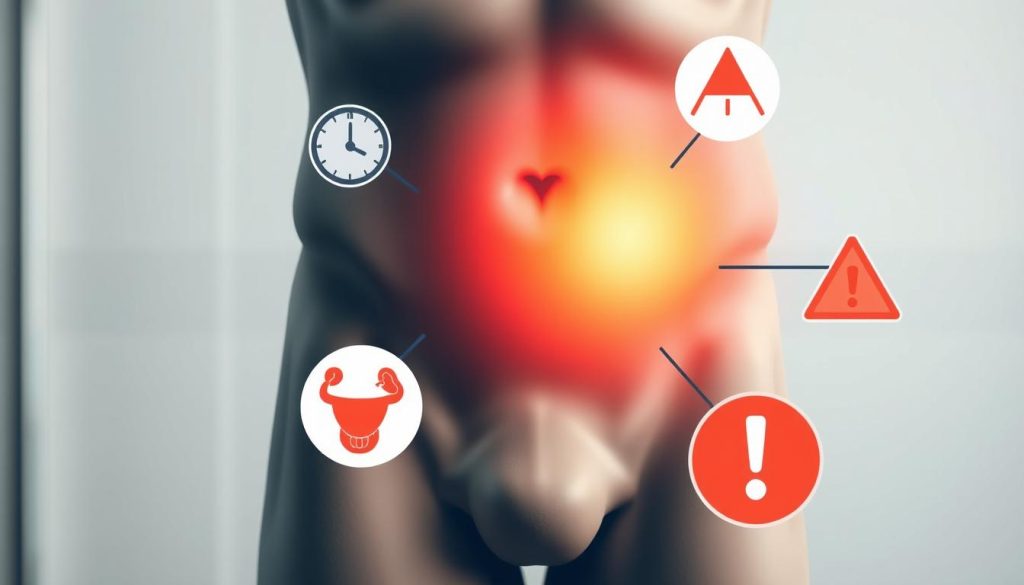
Making the Doctor’s Appointment
When you’re planning to see a doctor for prostate cancer concerns:
- Make a list of your symptoms and how long they’ve lasted
- Collect your medical history, including any family cancer history
- Remember any medications or supplements you’re taking
- Write down questions about screening and treatment for prostate cancer
| Symptom | Action |
|---|---|
| Mild urinary changes | Schedule regular check-up |
| Persistent pain or discomfort | Book appointment within a week |
| Severe symptoms or bleeding | Seek emergency care immediately |
Early detection is key to better outcomes. Don’t delay if you notice any worrying prostate cancer symptoms. Your health is worth acting quickly.
Treatment Options and Symptom Management
Dealing with prostate cancer can be tough, but knowing your treatment options is key. Treatment plans often mix different approaches based on each patient’s needs. Surgery is a common choice for early-stage tumors. Radiation therapy, like external beam or brachytherapy, targets cancer cells effectively.
Hormone therapy might be suggested to slow cancer growth. It works by lowering testosterone levels. In more advanced cases, chemotherapy is used to fight cancer cells. Your doctor will talk about the benefits and possible side effects of each option.
Managing symptoms is a big part of prostate cancer care. Palliative treatments aim to ease pain, urinary issues, and other discomforts. These can include medications, lifestyle changes, or special therapies. Remember, symptom management is important at every stage of treatment.
Your healthcare team will help create a plan that fits you. It’s all about balancing treatment with your well-being. Talking openly about your symptoms and worries is essential for the best care.
FAQ
Q: What are the most common symptoms of prostate cancer?
A: Common symptoms include frequent urination, trouble starting or stopping, and a weak stream. You might also see blood in urine or semen. Erectile dysfunction and pelvic pain are other signs. But, early cancer often has no symptoms, making regular checks key.
Q: At what age should men start getting screened for prostate cancer?
A: Men should talk to their doctor about screening at 50. But, if you’re African American or have a family history, start at 45. This is because you’re at higher risk.
Q: How is prostate cancer diagnosed?
A: Doctors use a PSA blood test, digital rectal exam, and sometimes a biopsy to diagnose. MRI might also be used to see the cancer’s size and spread.
Q: What’s the difference between prostate cancer symptoms and BPH symptoms?
A: Both can cause frequent urination and a weak stream. But, BPH doesn’t usually cause blood in urine or semen. Only a doctor can tell the difference.
Q: Can prostate cancer cause lower back pain?
A: Yes, advanced cancer can cause lower back pain if it spreads to bones. But, most back pain isn’t from cancer. See a doctor if you have ongoing pain, along with other symptoms.
Q: How does prostate cancer affect sexual function?
A: It can lead to erectile dysfunction, less desire for sex, and changes in ejaculation. These issues can be from the cancer or treatment side effects.
Q: What should I do if I notice blood in my urine?
A: Blood in urine needs quick medical attention. It could be cancer, but also other issues like infections or stones. A doctor can find out and treat it.
Q: How often should I get my PSA levels checked?
A: PSA testing varies based on age, risk, and past results. For men 50-70 with no risk, every 1-2 years is common. Talk to your doctor about your schedule.
Q: Can prostate cancer be prevented?
A: No sure way to prevent it, but healthy habits can help. Eat well, exercise, stay slim, and don’t smoke. Regular check-ups are also key for early detection.
Q: What treatment options are available for prostate cancer?
A: Treatments depend on the cancer’s stage and your health. Options include active surveillance, surgery, radiation, hormone therapy, and sometimes chemotherapy. Your team will choose the best plan for you.












